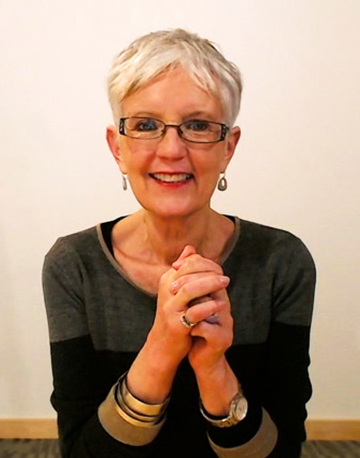How to Work with Emerging Defense Responses to Trauma (Beyond the Fight/Flight/Freeze Model)
 |
with Pat Ogden, PhD;
|
 |
with Pat Ogden, PhD; Stephen Porges, PhD; Bessel van der Kolk, MD; Janina Fisher, PhD; Kathy Steele, MN, CS; Deb Dana, LCSW; Ruth Lanius, MD, PhD; Thema Bryant-Davis, PhD; Ruth Buczynski, PhD
Sign up for the Gold Package

This is a learning community for practitioners. We can’t wait to hear what you’re going to use with your clients
But please do NOT:
- seek advice for personal problems
- ask for referrals
- post links or advertise a product
- post about technical problems
As a survivor of long-term, complex trauma, I am finding these lessons extremely valuable. As a survivor, I am able to better understand the failure of a long term therapeutic relationship I had years ago. These talks bring to light how, many times, a misdiagnosis can be made simply because there was such a lack of understanding of the experiences I was having; this resulted in the therapist’s nervous system kicking in, resulting in resignation/collapse and double consciousness. As a therapist, I can now utilize these tools to check in with myself when I notice subtle changes in my client’s behaviors, or energy. I notice I am very attuned to these, which, in many instances, I take to my own therapy sessions.
There are many parts to these lectures that I can use in my daily practice with all my clients, including children, adolescents, individuals, and families. The one I think will be most useful this week will be the please-appease. I look forward to the class tomorrow as I have a client dealing with a very pervasive sense of shame.
Thank you for these awesome presentations.
Maria P.
Thank you all at NICABM, and your presenters, for illuminating the mechanisms of trauma responses, recognition, and healing. For me, it is line up on line, precept upon precept, here a little, there a little. The insights I glean from experts is helping me understand how to recognize and navigate the next steps of my own healing.
Very importantly, as a live-in caregiver, you are giving me precious tools for understanding how – and how not – to engage with the dear souls I assist and coach. That is making me a more valuable partner on their journey to healing, whether in this life or the next, while avoiding unintentionally adding to their challenges by misreading their nervous systems. I can’t thank you enough. The Lord bless you for the manifold ripples of good these masterclasses are sending out.
Your experience of dealing with trauma informed therapists is very common. That language is a red flag that a therapist knows nothing about treating trauma. It is marketing.. What generally happens is clients with trauma seek them out and engage with them. Once the client feels safe enough to display these trauma responses, the therapist gets dysregulated and abruptly terminates the client–adding significant trauma to an already traumatized client–and always sending the message that the failure is the client’s fault. It is strange to me that at no time does any one of these experts acknowledge that dumping trauma clients is a very common response by trauma informed therapists. Those words mean nothing. No trained trauma therapist would ever use them.
This is helping with my own trauma responses.
This made me more aware of where I have my own defensive reactions with clients,
This was most enlighening.
Understanding these defense responses and how to rewire is so important, I hope to learn more specifically about the HOW. This knowledge and these tools are so needed to break the generational chains of abuse trauma and have healthy relationships. Please and Appease has more aspects as a survival reaction than those mentioned in this session, or it maybe it blends with Attachment Cry for Help. Attempting to meet emotional need for love and acceptance from family, friends, or group, attempting to prevent abandonment, and getting cooperation in getting help for physical and material needs from others that you cannot do for yourself. I have wondered if these are not children of the original response to threat, danger of abuse and anger etc. from the abuser. There are many entangled genetic and trauma components along with toxic family systems passed down thru generations.
Do the children of parents with genetic mental illnesses, and generational Abuse/Sexual Abuse Trauma actually physically inherit a nervous system predisposed or born wired with parents and past generations of trauma, and then further damaged by abuse they receive as a child? And then reinforced in a toxic family system that was handed down as well?
Dear Ruth et al,
This was such a very well-crafted episode!
Beyond the f/f/f methods of coping in the world…Cry-submit & please & Appease can be very tricky, I personally suffered with this in my early 20s not understanding what was happening. Now As a therapist It of course is a bit of a Blindspot therapeutically as to how to proceed… The understanding that this is may be a sympathetic state and not ventral or dorsal state was new to me and key to helping me know how to better approach and Assist this client, without further exacerbating this method of coping. Deb Dana is a refreshing, insightful voice in the polyvagal vein…
What was very helpful to hear and start learning more on:
Helping patients get out of the dorsal Vagal shutdown Response.
– being attended to it in patients and also monitoring your nervous system adaptation in session ( As the clinician therapists was truly enlightening to me.
I was reminded about how important it is to use language that fits the present state of the nervous system and how it can be counteractive to label or use language someone is not ready for. I really appreciated the understanding of the function of the three defensive responses of the nervous system and how psychoeducation/understanding these states is an effective way to thank that part for the various protections they provided and move forward with shifting to more of the ventral-vagal state.
Please/Appease (protect from further mistreatment)
Collapse (protect from the pain of present traumatic event)
Attach/Cry (allow for survival).
It is really helpful to think about the defensive responses in this way 🙂
I learned that it is possible to teach self-regulation to clients by practicing role-playing the 3 states of the nervous system with them during sessions.
PLEASE PLEASE stop referring to our clients as PATIENTS. It pathologizes and is condescending!
Yes I agree – please !
Thanks you!!
I am learning much more about the please/appease response with myself–as well as new alternatives in my own relationships.
Thanks so much for this training!
Michele
This section encourages me to integrate more practicing with clients in the different nervous system states to build their tools and range.
I’m enjoying and beginning to use this program with my clients. I think it would be helpful if presenters who suggest relying on the therapist nervous system or helping client observe their own nervous system could be more precise in what we are looking for. If I say, “Today, my nervous system is telling me X”, what am I actually referring to? I am beginning to try to explain the nervous system function to a client who has a low educational background (in Spanish) and want to use language she can understand and absorb. Even the term “activating your nervous system” seems vague. I have gone over “high activation” and “low activation” but I’m not certain she understood it.
I also at times feel uncertain whether certain reactions in my client are parasympathetic or sympathetic reactions. For example, before she goes into “freeze,” is she in a sympathetic “fight or flight” state or is she in a parasympathetic “collapse” state. Or is it a brief sympathetic, “fight or flight” first, followed by parasympathetic?
NICABM is offering Stephen Porges’ Why the Vagal System Holds the Key to the Treatment of Trauma for 1/2 off as of 6/20/24 ($97). The Polyvagal Institute has resources in Spanish.
Another great session, looking forward to tomorrow!
Question: is it possible/common to see the different survival responses in the same cliënt, in their different parts, as they have multiple trauma’s from different ages? (eary childhood, adolescent)
Janina Fisher recommends tracking ANS states and defense/survival responses to help identify parts.
Thank you very much for today’s broadcast. i found it very helpful. I often use strategies that I learned from you ti work with my many clients. Wirking with trauma is my passion.
I also need to ask a question. I bought your Gold package some time ago but don’t know how to acsess the material. Could you, please, advise. My email adress is verafl@aol.com Thanks beforehand.
Thank you for another thought provoking program.
I NEVER understand what Deb Dana is talking about. The others are clear but Deb’s language is ???????. I have no idea.
Deb’s work is based on a concept about a nonverbal part of the brain, the autonomic nervous system ANS, called Polyvagal Theory PVT. PVT posits that humans interact with others based on three ANS states: 1. ventral sociability-people are more safe than they are dangerous, try to attach. 2. sympathetic action-people are more dangerous than they are safe, try to flee or fight. 3. dorsal collapse-there is nothing I can do and no help is on the way, try to save energy and numb so as to not feel the pain. Deb teaches clients to regulate the ANS.
I got so much out of today’s session. The practical applications are greatly appreciated as it is wonderful to understand the “theories” and “methodologies”, but having hands-on approaches discussed, such as recognizing when the response state is dorsal/sympathetic/ventral and how to work with them, was very helpful.
I also appreciate the reflection pieces on the therapists’ regulation and monitoring in response to these presentations from the client. Very informative and useful. Thank you!
I’ve been reflecting on the work I do with traumatized children and teens. Paying more attention to the interplay between sympathetic and dorsal vagal responses, especially with teens who can sometimes vacillate between the two very quickly. I’m also going to be utilizing more of those somatic strategies to help with the teens who are in collapse. I struggle the most with clients who are hypo-aroused and often can feel it in my own nervous system. When this happens I begin to feel stuck in session. But the somatic approaches seem like something I can lean into more, for myself and my clients. The attach/cry and appease responses show in many of my younger clients who fear getting in trouble or may appear clingy to the adults in their lives. I can use some of what I’ve learned to work with caregivers, explaining the underlying nervous system engagement and teaching responses that will help move the children to ventral vagal states.
Not a practitioner, a writer. I use this info to better understand my own responses to experience and those of people I care enough about to share info with them, when possible (they have enough background to take it in), and to try to improve relationships, with myself and them. The basics of the nervous system and its responses to danger, now that we know of them, should be taught from childhood, and to all adults who missed this knowledge growing up — i.e, most people, not forgetting heads of militaries. Familiar with the bare basics of the polyvagal theory, I esp. appreciate hearing from Deb Dana and understanding behavior through this perspective in particular. It’s all quite simple in theory, very complex in the living of it.
Outstanding session. I am wondering where we can find more information on how to distinguish between attach/cry and borderline personality disorder.
Also, how can we distinguish between ongoing collapse submit symptoms and the task paralysis associated with inattentive type ADHD?
great questions! also curious about the anwsers!
There is no need to ‘distinguish’ between attach/cry for help and BPD. All cases of BPD (unless it is a misdiagnosis) are trauma related, BPD is in and of itself a trauma-related disorder, all of it’s symptoms can be understood through the lens of trauma, and the disorder is tragically sitting in the wrong section of the DSM. There is no such thing as trauma survivors vs. ‘true’ BPD, that is a myth that was sadly upheld by her poor choice of wording…
I agree. BD is a trauma adaptation. It always amazes me that the DBT techniques are specifically supposed to be for clients with BPD, yet DBT therapists do not permit their clients to talk about trauma, and they terminate them abruptly if clients do NOT please and appease. I hear this time and time again.
Thank you for this very good session. It has opened up new insights for me. Especially the parts of setting bounderies as a therapist instead of pacing with (and plaesing) the client. I ‘m also inspired by how playful Pat Ogden works with the body in the here and now.
Our nervous system is like a book and if we can read it thoroughly through the client’s narrative we will learn so much more than the words they use. Powerful for us as Practioners but more importantly, an excellent tool for the client to utilize at any time in their life.
I really appreciated hearing the differences between attach/cry for help and Borderline Personality Dis. I am working with a few clients where BPD didn’t fit and this is such a lightbulb moment for me! Will definitely be more attuned for all three of these states!
Hi,
I’m so taken with the fact that, as a client myself in therapy, NONE of these obviously important elements in therapy are not discussed or seemingly any part of my own therapy sessions. I believe that my therapist isn’t aware of these ideas. She isn’t an LCSW or a Psychologist or psychiatrist. I work with my therapist through Zoom, so how would I find a truly knowledgable therapist in terms of the material discussed over these 3 days and onword, perhaps referred by your organization, to truly dig as deeply as is necessary for a deep therapeutic experience? I’m JoAnne Leff in NYC with email: jleff41@gmail.com and phone: 212 874 2835. Thank you for your informative broadcasts!!
Lots of very useful tips! Thank you. I value the polyvagal approach, specially adapting it to work with autistic adults, in order to recognize their own “collapse”, “pease/appease”,”cry for help” responses. I will start using pictures or other sensory inputs to acknowledge this mechanisms, and develop ways to engage and learn from their own nervous systems (build their own “dictionary”). Being different often comes with trauma, and this session was very helpful for me. As a therapist, I will be more aware of my own ways of setting boundaries & using “righ brain to right brian communication” when my clients shutdown.
Helpful to have concrete concepts for nervous system state – this was my second intro to the polyvagal theory, but now with application examples. Also appreciate the idea of both the client and therapist saying no and saying yes in all three states.
Thank you so very much for the last 3 Days. I have enjoyed, and learnt soo much. Sadly, at the current South African exchange rate, as much as i would love to own the package, it is just not viable, given our Economy. But thank u for the ability to share it and hear all the advice. Good luck and Good Therapy to you All.
Looking forward to the next 2 sessions. i will look for you all on Utube, and hope to find more bits of Gold there.